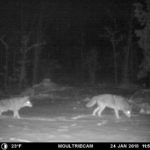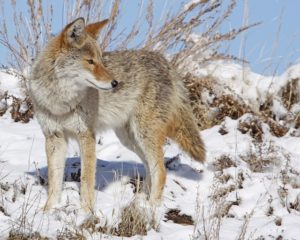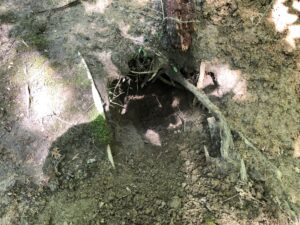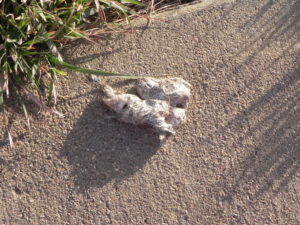
Night activity
Coyotes have moved into town. They’re showing well within huge cities and towns from the Atlantic to the Pacific. Sometimes early news reports of urban coyotes bring concern among residents. Are they dangerous? If you listen to media or follow social media then you might reach one conclusion. And, if you use logic you come to a more reasonable conclusion.
Long Relationship With Coyotes

Coyotes are secretive creatures.
Our relationship with coyotes goes back decades. In the fall of 1971 Rich worked for a farm chemical company in Idaho, delivering fertilizer to wheat farms. One day after he and a farmer unloaded the truck, they sat on the tailgate eating lunch. Across the harvested wheat field, a coyote emerged from the woods and pranced along the field’s edge. Although he was far away, we saw him successfully catch a tiny animal, probably a mouse.
The farmer said, “There goes my best employee. That coyote works night and day catching mice that eat my crops. He never complains, doesn’t expect a paycheck, and completely takes care of himself.”
Coyote Expansion
Back then coyotes mostly lived in rural areas from the Midwest to the Pacific Ocean and north to the Arctic. They never abandoned their rural roots, but over the years enterprising coyotes moved into towns and cities and expanded their range to the Atlantic. Now they’re common across nearly all of North America. Although rarely spotted, coyotes have moved into town.
Adaptable Coyotes
Coyotes are amazingly cunning and adaptable animals. Their much larger cousins, timber wolves, were trapped and shot to extirpation in most areas. Despite centuries of human persecution, coyotes kept expanding. Unlike wolves, they learned to adapt to living in close proximity to humans.
Local Coyotes
 For many years a coyote pair maintained a den and raised litters of pups in a den about 300 yards from our house. We don’t see them often but spot their tracks crossing our lawn after a new snow. Every once in a while, a distant ambulance or police siren warns motorists to pull over. Often “our” coyotes respond by singing just after the siren stops. Sometimes they yip and yap with no obvious triggering sound. We love hearing them. YouTube has many videos of coyotes howling.
For many years a coyote pair maintained a den and raised litters of pups in a den about 300 yards from our house. We don’t see them often but spot their tracks crossing our lawn after a new snow. Every once in a while, a distant ambulance or police siren warns motorists to pull over. Often “our” coyotes respond by singing just after the siren stops. Sometimes they yip and yap with no obvious triggering sound. We love hearing them. YouTube has many videos of coyotes howling.
Diet

Tell tale sign of coyotes
Although a coyote’s favorite meal is a mouse, cottontail, or other small mammal, they enjoy a varied diet that can include fruit, dead roadside animals, discarded pizza slices in an urban alley, and a host of other goodies.
Are Coyotes Dangerous to People?
Everything’s relative. Since 340 million Americans live close to coyotes it’s amazing how few incidents occur. They do happen, with the highest number of coyote bites happening in California. For detail check out publications at Urban Coyote Research Project.
Contrast that with deaths caused by dogs. Their bites cause an average of 43 human fatalities a year.
Are They Beneficial
They sure are. Drive through suburbia on a June evening and odds are that juvenile cottontail rabbits are hopping on lawns, in gardens, and across roads. Do the same drive in the fall and only an occasional bunny may be sighted. If left unchecked both rural and urban areas would be overrun with mice, rabbits, voles, and rats. Thank coyotes and owls, hawks, and foxes for keeping prey numbers at a low enough level to make gardening possible,
How In the World is “Coyote” pronounced
We prefer the Idaho pronunciation “coyOTE” with two syllables. Others say coyoTEE with three syllables. Take your pick.
Back to the story of the farmer. After he spotted the coyote stalking mice in his field he yelled out, “Thanks, fella. Keep up the good work!” Anyone might say the same when they spot a coyote anywhere……but be cautious. Never approach one closely, particularly if it seems ill or injured. Keep a distance away. Usually, it will slink off as soon as it spots a person.


Most interesting, thanks. Please consider a blog on coywolves, seen out here in Ohio and more interestingly, in a northwest DC residential neighborhood in daytime. Diurnal, huge and bold as you please. I only wish I had taken a photo of them.
We will have to pursue this. You have mentioned before so we will follow up.
Great post. Here’s a research paper that might be of interest. I thnk I shared it with Rich already, but if not, here it is: https://extension.oregonstate.edu/animals-livestock/sheep-goats/using-coyotes-protect-livestock-wait-what
Thanks, Dan!